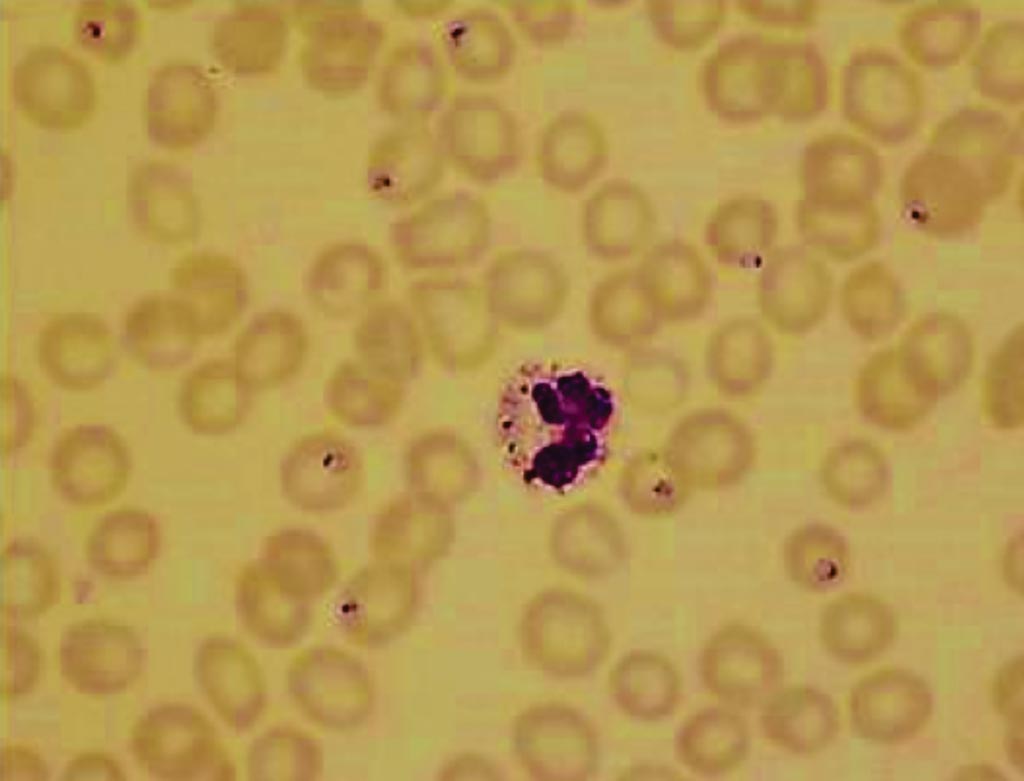Leukocyte Counts Change in Liver Phase of Malaria
By LabMedica International staff writers
Posted on 22 Nov 2017
Both in endemic countries and in imported malaria, changes in total and differential leukocyte count during Plasmodium falciparum infection have been described.Posted on 22 Nov 2017
In clinical studies, both in endemic countries and in patients with imported malaria, the most pronounced change is the decrease of peripheral lymphocytes. Lymphocytopenia has been observed in 45% to 63% of patients with an imported P. falciparum infection, but was less prominent in patients with some degree of anti-malarial immunity.

Image: Thin blood film showing ring-form trophozoites of Plasmodium falciparum and a neutrophil containing malaria pigment (Photo courtesy of Hammersmith Hospital).
A team of Dutch scientists working with the Institute for Tropical Diseases, Harbour Hospital and the Erasmus Medical Center (Rotterdam, The Netherlands) performed two separate Controlled Human Malaria Infection (CHMI) studies to study the exact dynamics of differential leukocyte counts and their ratios; they were monitored in a group of healthy non-immune volunteers. In two CHMI trials, CHMI-a and CHMI-b, 15 and 24 healthy malaria-naïve volunteers, respectively, were exposed to bites of infected mosquitoes, using the P. falciparum strain NF54 and the novel clones NF135.C10 and NF166.C8. After mosquito bite exposure, twice-daily blood draws were taken to detect parasitemia and to monitor the total and differential leukocyte counts. All subjects received a course of atovaquone–proguanil when meeting the treatment criteria.
A total of 39 volunteers participated in the two trials. All 15 participants in CHMI-a and 20 of the 24 volunteers in CHMI-b, developed parasitemia. During liver stage development of the parasite, the median total leukocyte count increased from 5.5 to 6.1 × 109 leukocytes/L, the median lymphocyte count from 1.9 to 2.2, and the monocyte count from 0.50 to 0.54. During the subsequent blood stage infection, significant changes in total and differential leukocyte counts lead to a leukocytopenia (nadir median 3.3 × 109 leukocytes/L), lymphocytopenia (nadir median 0.7 × 109 lymphocytes/L, and a borderline neutropenia (nadir median 1.5 × 109 neutrophils/L. The neutrophil to lymphocyte count ratio (NLCR) reached a maximum of 4.0. Significant correlations were found between parasite load and absolute lymphocyte count and between parasite load and NLCR.
The authors concluded that during the clinically silent liver phase of malaria, an increase of peripheral total leukocyte count and differential lymphocytes and monocytes occurs. This increase is followed by the appearance of parasites in the peripheral blood after 2 to 3 days, accompanied by a marked decrease in total leukocyte count, lymphocyte count and the neutrophil count and a rise of the NLCR. Both the lymphocyte count and the NLCR correlated with blood parasitemia, and all parameters had normalized 3 to 4 weeks after parasite clearance. The study was published on November 10, 2017, in the Malaria Journal.
Related Links:
Erasmus Medical Center













